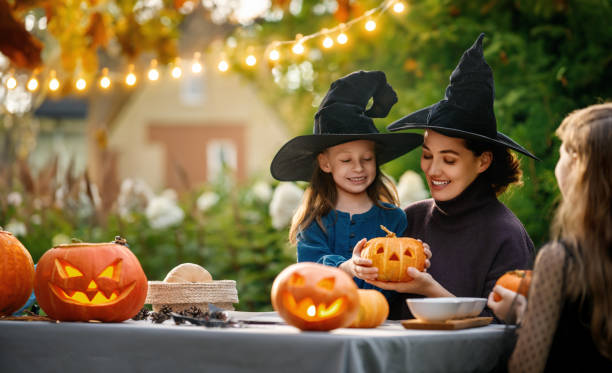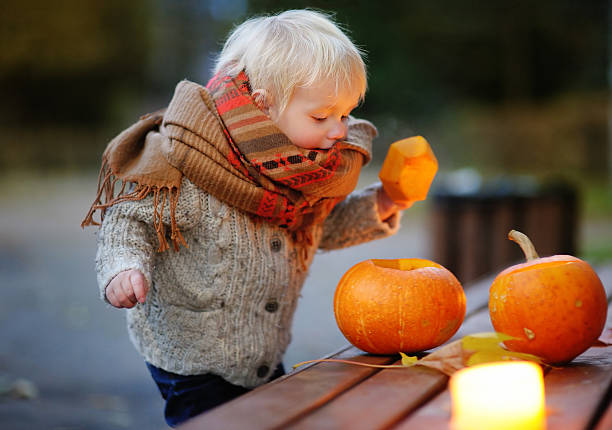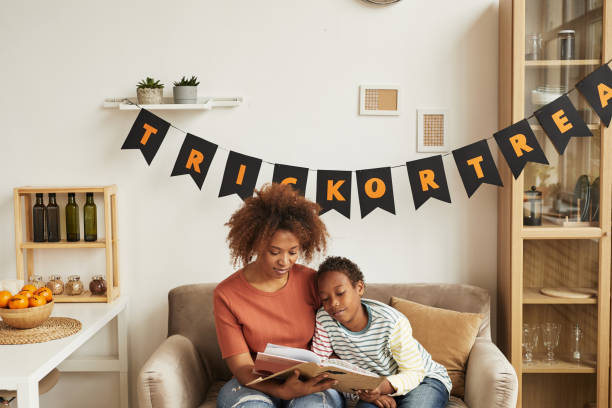
Halloween can be a fun and exciting time for kids, filled with costumes, candy, and creativity. But what happens when your child says they don’t want to dress up for Halloween? This can catch parents off guard, especially when other children seem excited about costumes and trick-or-treating. If your child wants to trick-or-treat but doesn’t want to wear a costume, you might experience worries about the comments they might get when they show up at certain houses. Furthermore, as all parents know, children are wont to change their minds about things without realizing that solutions don’t appear like magic in front of them. The amount of work and planning that goes into procuring a costume for your child isn’t likely going to be feasible at 5:58 p.m. on Halloween night. A very young child will never be able to understand why they can’t have a costume last minute, and you know that. Determining how to manage the fallout – however, that fallout looks – can cause anxiety and a massive increase in the pressure you are feeling to try to have a festive celebration.
Why Some Kids Don’t Want to Dress Up

Children can have various reasons for not wanting to wear a costume. We come across a variety of reasons in our Woodland Hills child therapy sessions. It could be sensory sensitivity, where the fabrics, masks, or makeup feel uncomfortable. For some, Halloween costumes might evoke anxiety, especially if they’re expected to wear something scary or unfamiliar. Other kids may struggle with decision-making, feeling overwhelmed by the pressure to choose a “perfect” costume. There may also be cultural or personal preferences at play—your child might simply not enjoy Halloween traditions as much as their peers. Understanding the underlying reason behind their reluctance can help guide how you respond and support them, allowing them to feel heard and respected without forcing participation.
3 Ways to Support Your Child’s Feelings
- Offer Alternatives to Full Costumes:

While you don’t want to pressure your child to wear a costume if they’re dead set against it, if their reasoning implies that they might actually want to dress up in some way, it’s a good idea to try to troubleshoot with them. In order to do this, you have to investigate what it is about dressing up that your child is avoiding. They might not fully be able to articulate what the problem is themselves; in this case, you can only do your best. Being as casual as you can, you can ask leading questions, such as, “Do you like the idea of wearing a mask?” or “Is there a certain color you think you’d enjoy wearing?” Simplify this process by making as many of these questions “yes or no” questions as possible.
If anything, this will be a great way to practice boundaries with your child. They can say yes to some of the ideas, and no to the rest. This is a life skill that will benefit them as they get older; they will know that being in for a penny doesn’t mean they’re in for a pound. It will also give you the chance to earn and strengthen your child’s trust in having conversations with you about things that are uncomfortable to them. It doesn’t need to feel heavy-handed to help improve communication skills, and you don’t need to spend a long time in conversation to show your child that it is safe to explain their thoughts and feelings to you.
You might determine that a sensory issue is causing your kiddo’s aversion to dressing up. Rather than a full costume, see if your child would prefer something simple, like wearing a Halloween-themed t-shirt or a favorite character accessory. This way, they can still feel part of the fun without the pressure of a full get-up. Letting them choose how they want to engage with the festivities can help ease resistance.
If the issue is wearing some sort of mask, there might be other costumes that your child might enjoy wearing. Or, it might not have occurred to them that they can go out as that character without a mask. Remind them that masks can impair eyesight, anyway, and it’s actually safer to be out without one. If the issue is the fabric of a certain costume, see if you can source a similar version of it with a different fabric.
You can also offer an alternative that is a full costume but doesn’t feel like a costume. If your kiddo and their dad have matching tee shirts, it might be easier to suggest, “Do you want to wear this with some shorts and go as Daddy?” Dad can get in on the fun and wear his tee shirt, too; now they’re twins! The same can go for any family member or friend who might have a look that can be created using “normal” clothing, no masks, and no makeup. Everyday clothes can also become the costume of any superhero in their alter-ego existence. Put a pair of glasses on your kid and he’s Peter Parker or Clark Kent.
Consider if you can use other family members to inspire a piece of a costume if your child is interested in “sort of” dressing up. Wearing their everyday clothes and walking behind a younger sibling all night could be marketed as being an undercover bodyguard for whatever character that sibling is dressed as. Or if there is a family theme with consistent color, your kiddo can wear clothing of their own in that same hue without being in the full costume.
- Get Creative with Participation:

There is no reason why your child has to dress up in order to participate in Halloween. Sometimes, children enjoy the creative aspects of Halloween, like decorating the house or carving pumpkins, even if dressing up isn’t appealing. Focus on what your child does enjoy, whether it’s helping make spooky snacks or picking out decorations. This keeps them involved in the celebration without costumes being the center of attention.
When we talk to the children who see us here for child therapy in Woodland Hills, the overarching theme for any fun event is often that “everyone was together”. We can get caught up in our own childhood memories, traumas, or wounds, and feel that things have to be a certain way in order for our children to feel loved, to feel celebrated, and to have a good time. In in-person and online child therapy sessions, we hear over and over again how anything can be fun, and any small moment can be the highlight of the day. When you’re trying to decide what to do with your child(ren) to get them in the Halloween spirit, odds are that anything that sounds fun to you will end up being pretty fun for them.
Leaning into other options to make Halloween feel special is a great way to get to know your child better. There are lots of options for activities you can do together; start with asking your child if they have a preference. “Is there something you’d like to do to celebrate Halloween?” They might not have any ideas, and you can begin making suggestions. They might try to communicate something they’ve heard about vaguely at school or at other social events; maybe you’ll figure it out, and maybe not. Or they might just come out with the thing they’re most excited about. It might surprise you! Maybe it will be something you have in common, and you can share excitement. Maybe it will be something new that you can practice working on together.
When it’s not all about the costume and the night itself, you can make the lead-up to Halloween an ongoing series of activities that seem just as important as October 31st. Set aside some evenings to make some popcorn and watch a spooky movie or two. Decorate the house, inside and/or outside. If you want to do crafts with your child to make the decorations, that’s another fun way to get in the Halloween spirit! If you’d prefer to shop, choosing a fun new item to add to your collection of decor is also something your child might enjoy. Crafting can be as simple or as involved as you are able to make it. Drawing pictures or cutting out ghosts to put around the house can be just as fun and satisfying as assembling kits or creating items out of paper mache.
There are lots of public activities to participate in, such as local museums and galleries offering Halloween-themed events. In fact, when your kids are old enough, there are theme parks that specifically prohibit costumes for visitors… if you dare. There are also others where costumes are permitted (within guidelines) but not mandatory. Visiting a garden of carved pumpkins or even just a pumpkin patch can be festive and exciting without any sort of costume.
- Respect Their Decision:

Ultimately, it’s important to respect your child’s choice. Halloween should be fun, not stressful. By giving your child the autonomy to opt out of wearing a costume, you’re sending the message that their preferences matter, which fosters trust and emotional security. You can also remind them that not everyone dresses up, and that’s okay – there’s no “right” way to celebrate Halloween.
Approach your conversation with them from a place of curiosity. Make sure to explain that you’re not questioning them, but just trying to understand where they’re coming from, because their feelings matter to you. They might not know, or be able to put into words, exactly why they don’t want to wear a costume. Or, you might discover that they have anxiety around the opinions of their peers, or the pressure to have a “perfect” costume. Perfectionism can show up in conscious and unconscious ways, and Halloween is still relatively close to the beginning of the school year. There may be new dynamics at play that are impacting how your child feels about trying new things, making decisions, or participating.
In order to set yourself up to respect their decision, give yourself private space and time to deal with whatever feelings arise about your child not wearing a costume this year. If you yourself love to dress up and you look forward to choosing a costume every year, it may feel personal in some way that your child is eschewing that tradition. Respecting someone’s decision is an ongoing process that requires conscientiousness. For example, small frowns or expressing sadness whenever the subject of costumes comes up isn’t helpful. Looking through photos of past Halloweens and talking about past costumes with them isn’t helpful. By all means, if you want to set aside some time to be nostalgic on your own, go for it. The best way to experience acceptance is to actually confront what you feel. So long as you don’t make that process a job or burden for your child, it is perfectly reasonable to do so. This might be the only Halloween where your child doesn’t want to wear a costume, or it might be a one-off. There is no way to know.
All you can do is come to terms with your current reality and be alright with it.
While you might do your best to respect their decision, also prepare yourself that others might not. Part of respecting your child’s decision is advocating for them even when they’re not around. If you have family members who will be coming by, give them a heads-up that your child doesn’t want to wear a costume this year, and that any commentary about it or attempts to cajole or pressure your child won’t be tolerated. Lead by example; if you’re frustrated by your child’s choice, it can be easy to sign and express your disappointment when someone pushes back. Instead, you can respond with something simple, like, “It’s their choice, and I’d rather not pressure any of my children to do anything with their bodies they don’t want to do, including wearing a costume for a few hours. It’s not worth the anxiety to me. I’d rather they have fun.”

Anxiety about diverging from parents and/or parental traditions is something I hear about as a child counselor in Woodland Hills. Chances are that your child desperately wants your approval, and the idea of disappointing you or taking something away from your enjoyment of Halloween is upsetting to them. They may also be feeling pressure from schoolmates or other social peers to dress up, in spite of their aversion to the idea. This can be a great time to demonstrate that people-pleasing isn’t necessary in order to have a good time and be loved. If you are able to focus on things besides dressing up, you will see how much fun there is to be had that has nothing to do with a costume. Watching seasonal films, doing crafts and decorating, reading ghost stories, and carving pumpkins, all of these are great ways to celebrate Halloween. Upholding your child’s wishes will help them learn self-care, which is the best they could get out of any experience, anyway.
Child Therapy in Woodland Hills
In Child Therapy, we work closely with children to understand the challenges they face and help them navigate through their emotional and behavioral struggles. Whether your child is dealing with anxiety, difficulties at school, or social challenges, therapy provides a safe space to explore their feelings and find solutions. Children may experience anxiety that leads to panic attacks, obsessive behaviors, or trouble focusing, which can affect their confidence and ability to connect with others. Our goal is to help your child build resilience, manage overwhelming emotions, and develop the skills needed to thrive both socially and academically.
Contact us today for your complimentary 20-minute phone consultation with our Admin Team today!




